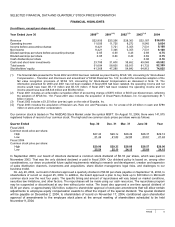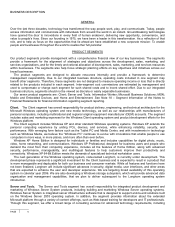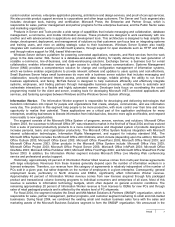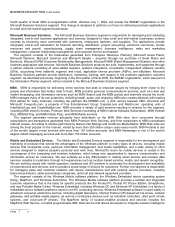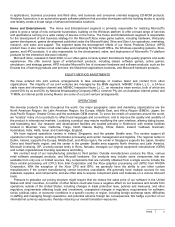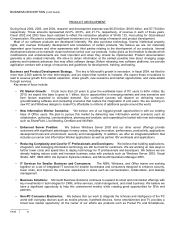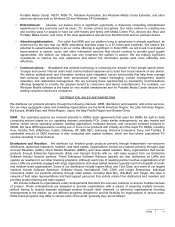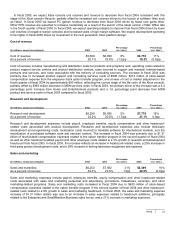Microsoft 2004 Annual Report Download - page 14
Download and view the complete annual report
Please find page 14 of the 2004 Microsoft annual report below. You can navigate through the pages in the report by either clicking on the pages listed below, or by using the keyword search tool below to find specific information within the annual report.
BUSINESS DESCRIPTION (CONTINUED)
PAGE 14
Oracle, PeopleSoft, and SAP, are repositioning some of their business applications to focus on small and medium-sized
business and thus also compete against us for a portion of this segment. In addition, there are thousands of other vendors
in specific localities or industries that offer their own enterprise resource planning (ERP), customer relationship
management (CRM), and/or analytic solutions. We believe that our business applications products across financial
management, supply chain management, and CRM compete effectively in our target segments by offering solutions and
services that address multiple segment needs across industries through consistent innovation in product functionality
delivered through a growing network of partners.
MSN. MSN competes with Yahoo!, Google, AOL, Earthlink, U.S. cable and DSL providers, and a vast array of Web sites
and portals that offer content and online services of all types. MSN also competes with traditional advertising and print
media. As the broadband access market grows, we expect to have increasing opportunities to deliver rich and compelling
services and experiences for consumers. MSN’s advertising revenue has grown considerably over the last year, and we
expect this trend to continue in display advertising as well as in search-based advertising, as online advertising continues
to gain market acceptance. This growth has led to competitors aggressively pursuing both advertisers and consumers
with expanded offerings and new technology. We are building our own algorithmic search engine and investing to support
the continued growth of our advertising business. Due to the continuing trend of consumers migrating from narrowband to
broadband Internet access, we expect our narrowband Internet access subscriber base to decline. We believe our
competitive advantage comes from our ability to empower people globally through information software and services that
help them find, discover, and experience what they want online.
Mobile and Embedded Devices. Windows Mobile software faces substantial competition from Nokia, Openwave
Systems, PalmSource, QUALCOMM, and Symbian. The embedded operating system market is highly fragmented with
many competitive offerings. Key competitors include IBM, Wind River, and versions of embeddable Linux from
commercial Linux vendors such as Metrowerks and MontaVista Software. MapPoint competitors include DeLorme,
MapInfo, Mapquest.com, Rand McNally, Webraska Mobile Technologies, and Yahoo! The telematics market is also highly
fragmented, with competitive offerings from IBM and automotive suppliers building on various real-time operating system
platforms from commercial Linux vendors, QNX Software Systems, Wind River, and others. We believe that our products
compete effectively by providing a familiar development framework that enables developers to easily write and deploy
innovative applications for mobile or embedded devices; providing a flexible platform that allows customers and partners
to build differentiated and profitable business models; and providing end users significant benefits such as ease of use,
personal productivity, and better information management and control.
Home and Entertainment. The home and entertainment business is highly competitive and is characterized by limited
platform life cycles, frequent introductions of new products and titles, and the development of new technologies. The
markets for our products are characterized by significant price competition, and we anticipate continued pricing pressure
from our competitors. These pressures have, from time to time, required us to reduce prices on certain products. Our
competitors vary in size from very small companies with limited resources to very large, diversified corporations with
substantial financial and marketing resources. We compete primarily on the basis of price, product quality and variety,
timing of product releases, and effectiveness of distribution and marketing.
Our Xbox hardware business competes with console platforms from Nintendo and Sony, both of which have a large
established base of customers. In addition to competing against software published for non-Xbox platforms, our games
business also competes with numerous companies that have been licensed by us to develop and publish software for the
Xbox console. These competitors include Acclaim Entertainment, Activision, Atari, Capcom, Eidos, Electronic Arts, Sega,
Take-Two Interactive, Tecmo, THQ, and Ubi Soft, among others. Success in the games business is increasingly driven by
hit titles, which are difficult to develop and require substantial investments in development and marketing. In addition,
other forms of entertainment such as music, motion pictures, and television compete against our entertainment software
for consumer spending. We believe that our Xbox products compete effectively by providing customers benefits such as
superior game console performance, exclusive game content, and innovative online multiplayer gaming through Xbox
Live. Our PC hardware products face aggressive competition from computer and other hardware manufacturers, many of
which are also current or potential partners.



